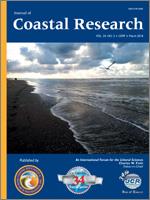Edwards, T.C.P. and Mitchell, S.F., 2018. Trace fossils in clastic beachrocks at the Yallahs Salt Ponds, Jamaica: Implications for beachrock cementation.
The extent and importance of trace fossils preserved in clastic beachrock from the southern section of the Yallahs Salt Ponds on the SE coast of Jamaica are described. The beachrock contains a seaward-dipping facies of cemented sandstones and conglomerates and a landward facies consisting of cemented sandstones packed with the trace fossil Psilonichnus, which is produced by the ghost crab Ocypode quadrata (Fabricius). The seaward-dipping bedded facies represents more than 95% of the beachrock at the Yallahs Salt Ponds and has an exposed height ranging from 6 to 50 cm and lateral continuity of 1 to 200 m. The bioturbated facies, which represents less than 5% of the beachrock at the Yallahs Salt Ponds, was only found at three localities. It has an exposed height of 40 to 60 cm, with outcrops traceable for 6 to 30 m along the beach. These bioturbated Psilonichnus-bearing units demonstrate that beachrock cementation occurred within the intertidal zone and the lower supratidal zone, where modern burrows of Ocypode are found. The high density of Psilonichnus burrows indicates multiple generations of Ocypode burrowing activity, demonstrating that the beach system was stable and was not affected by any tropical storms or hurricanes for an extended period before cementation. Psilonichnus burrows penetrate the entire thickness (up to 50 cm) of the beachrock at the three localities where they are preserved, and this indicates that a single episode of cementation was responsible for beachrock formation. A second episode of cementation is demonstrated by cobbles and blocks of broken beachrock cemented to the top of the exposed beachrock outcrop; this presumably occurred much later than the first phase of cementation.





